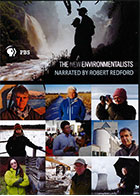
The New Environmentalists 2007-2016
Distributed by Green Planet Films, PO Box 247, Corte Madera, CA 94976-0247; 415-377-5471
Produced by Mill Valley Film Group
DVD, color, 10, 30 min. episodes on 3 DVDs
General Adult
Environmental Movement, Environmental Justice, Ecology, Politics, Environmentalism
Date Entered: 12/21/2017
Reviewed by Andrew Jenks, California State University, Long BeachIn 2006, PBS began to air what it calls the “new environmentalism.” The result is an important and well-produced series that chronicles the environmental movement of the early 21st century. It provides insight into the issues and challenges facing the environmental movement as well as an invaluable record for future chroniclers of its history. The series (narrated by Robert Redford) distinguishes the current age of environmentalism from previous ones in a number of different ways. The early environmental movement in the 19th and early 20th centuries focused on conservation, led by figures such as John Muir and the setting aside of land as national parks by Teddy Roosevelt. The focus shifted to the raising of a global consciousness and environmental awareness in the 1960s and 1970s, following Rachel Carson’s 1962 Silent Spring. In this phase, privileged and educated white people, mostly in Europe and North America, argued for new regulations on polluters and drew attention to the insidious effects of chemicals on ecological and biological systems.
The new environmentalism emerged out of the end of the Cold War and has been inspired by both the gains of the previous era and the limitations of its approaches. The seeming triumph of market capitalism in the immediate post-Cold War era ultimately highlighted the failures of the environmental movement to limit development and consumerism and to find a viable strategy of sustainable economic growth, especially in the developing world. The capitalist mantra of unlimited growth opened up more and more of the earth’s resources to a metastatic form of capitalist consumerism. Driven by the juggernaut of Chinese authoritarian capitalism and American-style marketing, unrestrained materialism and the quest for profit have triggered the even more aggressive exploitation of resources in Africa, Asia, and Latin America and in the process devastated global ecosystems and exacerbated global divides between rich and poor.
Independent of ideology and political system, the phenomenon of global capitalist development has put the problem of natural resource exploitation and human inequality into stark relief. Indeed, if conservation in rich countries was the banner of the first phase of the environmental movement, environmental justice in the developing world has driven the environmental movement in the first part of the 21st century. The environmental justice movement has attempted to bring environmental issues into the debate about civil rights and economic justice, illustrating the ways that environmental degradation is connected to the exploitation and disempowerment of poor people, women, people of color and endangered species. Each of the episodes focuses on the activists – everyday, common people -- who have attempted to promote a sustainable, just, and equitable form of economic development.
The ten episodes on these three discs offer an astounding variety of examples of environmental entrepreneurship – in Africa, Latin America, Asia, North America, and Australia. Each 30-minute episode features approximately six individuals engaged in creative attempts to protect endangered species, negotiate with powerful interests to protect land, fight multinational corporations engaged in massive resource extraction, find better ways to dispose of trash, develop more sustainable methods of agriculture, or protect marine resources. The short vignettes make this collection ideal for teaching in environmental science and studies courses as well as political science.
What also makes these stories compelling is that they do more than simply recount the familiar story of environmental degradation. They also tell the story of individuals who have attempted, often successfully, to develop alternatives to the practices and attitudes that have imperiled the global ecosystem. These individuals are not luddites urging a wholesale condemnation of modern technological life, but creative individuals seeking ways to integrate practices, attitudes, and technologies into more equitable and viable ways of moving forward into the future. Perhaps the greatest lesson from these stories is that they show that the grassroots development of more sustainable methods of resource management is connected to the recovery of democracy as well as the environment. To have the ability to control one’s environment is ultimately the most meaningful measure of people power, and by that measure, at least for now, most of the world’s population remains disenfranchised.